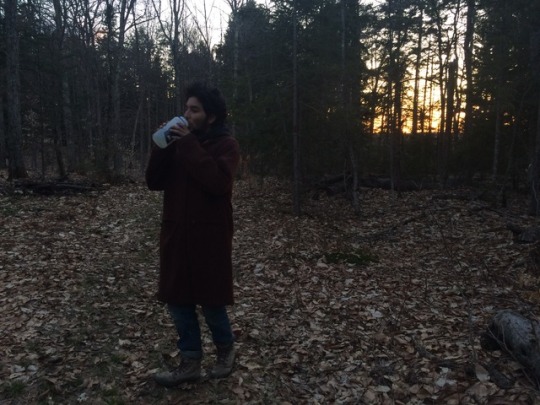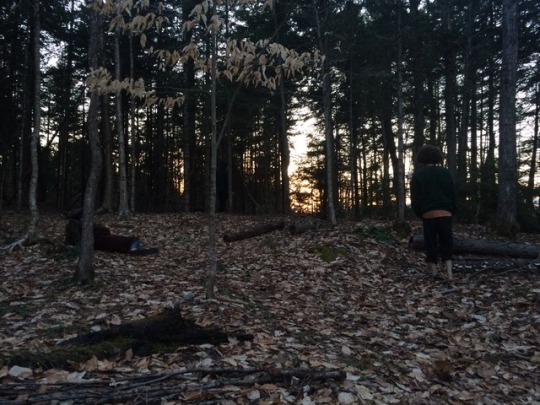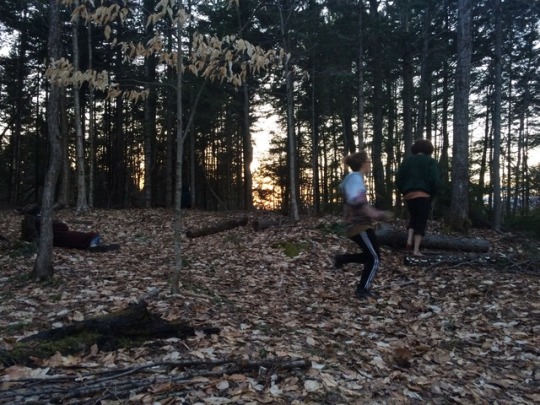#sonological competence
Photo



Soundwalk in Virginia Russell Woodlot. 4/23/17
3 notes
·
View notes
Photo

"-17 Soundscape" (2019)
6"x8" mixed media on paper
1 note
·
View note
Text
Sound Blog Post #4
In the article, “An Introduction to Acoustic Theory”, the author talks about how so many people that lacked “sonological competence”. I thought it was really interesting that this guy took 2500 hours out of his life to record and take notes on bug noises. The consensus that was found from this is that spectral niche is often masked by urban noises as communities continue to grow. I found it interesting that when in the lo-fi soundscape can be minimized so much that people can not hear their own movement or speech. It’s pretty crazy that guys in Papa New Guinea can imitate over 100 birds, but have no idea what each one looks like. What I found most interesting is the part about inner noise. The result of unexpressed emotions that build up in someone’s head over time could have distract effects on a society around the person. Some people struggle to deal with their inner emotions and act out accordingly when they have hit a breaking point. In summary, I feel like sound is one of those things that people undermine and do not give much thought to. It’s far more important than people give it credit for and interpreting it is very important.
0 notes
Text
“Schafer (1977) was worried about the dominance of the “eye culture” and the parallel loss of “sonological competence” in the modern societies.”
The relevance of soundscape research to the assessment of noise annoyance at the community level.
http://www.icben.org/2003/pdf/77_t6.pdf
We are always looking aren’t we? Never listening, more so looking for the next best thing, even when we are listening we are looking at something and are not even thinking about the sounds. I agree with this because when we look with only one sensory, we lose another. The trick is to intertwine both, to take notice of both senses. To create a sense perhaps?
0 notes
Text
A Study in Sonological Competence
For my Performance Ecology final I decided to change my focus from a visual project to an aural one. Visual modality is incredibly dominant in today’s society (R. Murray Schafer). An antidote to this problem is to develop a range of exercises such as sound walks, to maintain a high level of sonic awareness. This is what my project focused on. My essential question came out of an article about acoustic ecology by Kendall Wrightson: how does sonological incompetence hinder our ability to listen deeply to ourselves and those around us? Another antidote to this problem would foster a new approach to design as a result of imbuing us with an appreciation of environmental sound. The new approach to design should incorporate that appreciation, then reducing wasted energy that noise represents (Wrightson).
I think that all too often, we walk around with our ears shut -- if we walk around at all. A true state of listening cannot be forced, it’s just a gentle receptiveness. Listening implies a readiness for the unexpected while it grounds you in place. Without the ecological music of the place you’re inhabiting, you can become eerily ungrounded. Where is this sound proof classroom? It could be anywhere in the world … Where are the ecological sounds to mark it geographically? When we are cut off from the sounds of the natural world, it inhibits our ability to actively and deeply listen to each other. A deeper appreciation of the sounds of the natural world is required to bridge this gap. When asked the other day for 5 ecological sounds that I had heard that morning, I could only come up with 2. Though that might have been partly because of the weather (freezing rain, howling wind, general Vermont wintry unpleasantness), I also likely wasn’t listening as I walked along. I want to become in the habit of listening and invite others to join me.
I have gone on multiple solo soundwalks and one with four other people. On the evening of Sunday the 23rd of April, Jacob, Savannah, Chris, and Victoria and I went to the Virginia Russell woodlot to hear what we could hear. We left around 7:30 and spent about an hour in the woods, walking and then sitting to listen. We interestingly enough chose to sit right at the edge of where the mixed hardwood forest gives way to softwoods. The most notable sound for me was the birdsong we heard. According to Laura Beebe, it was either a Winter Wren or a Hermit Thrush (likely the latter). The song was very melodic and complex and was the foremost player in the soundscape. The next most prominent noise was the droning hum of the peepers and amphibians singing, one of my most treasured harbingers of spring, sun, and warmth. These sounds both brought me comfort and allowed me to focus on listening outwards. I didn’t really listen in to myself very much. I found it more meditative and helpful to focus on the sounds around me. I heard a lot of noise from passing cars on the road that made me feel anxious and a bit annoyed. They’re just so loud! One of my favored sounds from the experience was the wicked way the tired and bleached leaves of the Beech tree sounded when a breeze came through the canopy. It sounded almost like a zipper being unzipped. It was eerie and exciting. After sitting and listening for about half an hour, we had a brief circle up with an informal reflection on what we experienced. That audio is recorded in my playlist.
The cycles of the natural soundscape of the west coast of British Columbia showing the relative level of sounds in 1984 is pictured below. If I had more time I would have loved to record more audio, visiting different areas of the NEK with different people at different times of the day, to make such a soundscape diagram over the course of a year or at least 6 months.

I would also be interested to collect some endangered sounds of Vermont, which was a project originally done in the UK by Dr. John Drever, a professor of Acoustic Ecology at a London University. Some of the endangered sounds of the UK included the typewriter, slam door trains, newsvendors’ cries, traditional woodcutting, etc.
Notes from Wrightson reading:
-Unfortunately, since the Industrial Revolution, an ever increasing number of unique soundscapes have disappeared completely into the cloud of homogenized, anonymous noise that is a contemporary city soundscape. The preindustrial soundscape could extend for many miles. Thus, sounds emanating from the listener's own community may have been heard at a considerable distance, reinforcing a sense of space and position and maintaining a relationship with Home. The sense is further strengthened when it is possible to hear sounds ensnaring from adjacent settlements, establishing and maintaining relationships between local communities. In a post industrial soundscape meaningful sound can be masked to such an extent that an individual’s “aural space” is reduced. Where the effect is so pronounced that an individual can no longer hear the reflected sound of their own movement or speech, aural space has effectively shrunk to include the individual, isolating the listener from the environment. The pre-industrial soundscape is balanced in terms of level, spectra and rhythm. The post industrial soundscape features an almost constant level creating a “sound wall”, which isolates the listener from the environment. Due to the 24 hour society, the rhythms of daily routine are, in some localities, significantly eroded. Sound needs to be the mediator between listener and environment.
-As the soundscape deteriorates, so awareness of the subtleties of environmental sound has withered in proportion. as a result, the meaning sounds hold for the listener in contemporary soundscapes tends to be polarized into extremes, like loud and quiet, or good or bad. Compare this level of sonic awareness with the Kaluli men of Papa New Guinea who, according to Feld, can “imitate the sound of at least 100 birds, but if you can provide visual descriptive information on nearly that many.”
-Networks, transmitters, and satellites extend the acoustic community across the entire planet, a fact that has been utilized for fair deeds and foul Schafer refers to latter use of sound as “sound imperialism”.
-The psychological significance of sound used as a controlling force is that the environment and the community become the enemy. As with any war, the environment becomes a battleground and suffers as much as it inhabitants. Schafer estimated that the battle between sonic expression in control was helping to increase environmental sound levels annually.
-The use of sound as a sound wall to block the unceasing inner dialogue and uncomfortable emotions the dialogue evinces provides illusion of mastery over emotion. The psychological and physical cost of an unexpressed emotion is an epidemic of stress related illnesses that reflect a struggle to adapt to a new way of living.
-As the city represents excitement, so the countryside has come for many to represent boredom and a disconnection from life. “Life” has become associated with continuous noise and activity. Being “in touch” with the noise of opinion and technology becomes more valuable, well the quiet reality of how an individual feels can be devalued or ignored … the pre industrial soundscape represents a deep psychological fear for anyone whose purpose is to avoid their feelings. Being quiet tends to bring emotions to the surface.
1 note
·
View note
Text
An Introduction to Acoustic Ecology
Sound is incredibly important in communicating mood, meaning, and context.
Your level of awareness of the acoustic environment at any given time is an issue central to the inter-discipline of acoustic ecology, which suggests that we try to hear the acoustic environment as a musical composition and that we are responsible for its composition.
R. Murray Schafer, musician and composer, founded the concept and philosophy. He noted the incredible dominance of the visual modality in society. Eye culture reveals that children’s ability to listen is deteriorating. He argued passionately for listening skills to become an integral part of the national curriculum. He termed these listening skills “sonological competence”. Practical exercises such as listing environmental sounds that you remember hearing on a particular day revealed that many students could not recall having heard any sounds during the day and many cannot complete a five pronged sound list even after 15 minutes. The antidote to this problem was to develop a range of your cleaning exercises such as sound walks. The walking meditation has the goal of maintaining a high level of sonic awareness.
Sounds that are particularly regarded by community and it’s visitors are called “sound marks” – in analogy to landmarks. Natural examples can include waterfalls and wind traps, well cultural examples include bells or the sound of traditional activities.
The sound of a particular locality can express a communities’ identity that to the extent that the settlement can be recognized and characterized by their soundscape. Unfortunately, since the Industrial Revolution, an ever increasing number of unique soundscapes have disappeared completely into the cloud of homogenized, anonymous noise that is a contemporary city soundscape.
There is a huge contrast between pre-industrial and postindustrial acoustic environments.
The preindustrial soundscape could extend for many miles. Thus, sounds enemating from the listeners own community may be heard at a considerable distance, reinforcing a sense of space and position and maintaining a relationship with Home. The sense is further strengthened when it is possible to hear sounds ensnaring from adjacent settlements, establishing and maintaining relationships between local communities.
In a post industrial soundscape meaningful sound can be masked to such an extent that an individual’s “aural space” is reduced. Where the effect is so pronounced that an individual can no longer hear the reflected sound of their own movement or speech, aural space has effectively shrunk to include the individual, isolating the listener from the environment.
The pre-industrial soundscape is balanced in terms of level, spectra and rhythm. The post industrial soundscape features an almost constant level creating a “sound wall”, which isolates the listener from the environment. Due to the 24 hour society, the rhythms of daily routine are, in some localities, significantly eroded.
Sound is the mediator between listener and the environment.
As the soundscape deteriorates, so awareness of the subtleties of environmental sound has withered in proportion. as a result, the meaning sounds hold for the listener in contemporary soundscapes tends to be polarized into extremes, like loud and quiet, or good or bad. Compare this level of sonic awareness with the Kaluli men of Papa New Guinea who, according to Feld, can “imitate the sound of at least 100 birds, but if you can provide visual descriptive information on nearly that many.”
Networks, transmitters, and satellites extend the acoustic community across the entire planet, a fact that has been utilized for fair deeds and foul Schafer refers to latter use of sound as “sound imperialism”.
A 1966 report noted that “councils receive 300 complaints about unacceptable noise from neighbors”, and more disturbingly “over the past four years 18 people have been killed due to disputes over noisy neighbors”.
The psychological significance of sound used as a controlling force is that the environment and the community become the enemy. As with any war, the environment becomes a battleground and suffers as much as it inhabitants. Schafer estimated that the battle between sonic expression in control was helping to increase environmental sound levels annually.
The use of sound as a sound wall to block the unceasing inner dialogue and uncomfortable emotions the dialogue evinces provides illusion of mastery over emotion. The psychological and physical cost of an unexpressed emotion is an epidemic of stress related illnesses that reflect a struggle to adapt to a new way of living.
As the city represents excitement, so the countryside has come for many to represent boredom and a disconnection from life. “Life” has become associated with continuous noise and activity. Being “in touch” with the noise of opinion and technology becomes more valuable, well the quiet reality of how an individual feels can be devalued or ignored.
The pre industrial soundscape represents a deep psychological fear for anyone whose purpose is to avoid their feelings. Being quiet tends to bring emotions to the surface.
There are two ways to improve the soundscape. The first is to increase sonological competence through an education program that attempts to imbue students with an appreciation of environmental sound. This will foster a new approach to design, that will incorporate an appreciation of sound and thus reduce the wasted energy that noise represents.
The value of listening and the quality of the soundscape our values worth evangelizing. We should not underestimate the enormity of the task in the face of the busiest, loudest century in recorded history.
#an introduction to acoustic ecology#kendall wrightson#acoustic ecology#performance ecology#performance research
0 notes
Text
Catch up: Notes from 3/13/17
-Rituals are a way to live the myth
-Masks as a vehicle for liminal travel (transmigration)
-Living beyond the metaphor
-Deep ecology: Buddhism, interconnection, the great unity, co-dependence, nature’s rights
-The mask is a door or portal to spirit, allowing movements between the veil
-Social media as a mask. The trickster’s mask, the selfish mask. Social deviancy permissible or often conducted through mask wearing.
Sounds that I’ve heard today:
1. Wind howling
2. Snow whipping
3.
4.
5.
Sounds that I like:
1. Grease frying
2. Laughter
3. Doves cooing in the dawn light and twilight hours
4. Sounds of a meal in progress
4. The vibration of my phone when I get a text from the one I love :) aw.
Sounds I don’t like:
1. When snow is built up in my wheel wells and shakes the car loudly
2. When men yell or get aggressive
3. Loud chewing
4. Loved ones coughing or being otherwise ill
5. Squeaky shoes on tile floors
6. Off tune humming or singing
-Work in sonological competence
-Acoustic coloration
-The spectral niche
-Aural space
#acoustic ecology#performance ecology#performance research#rituals#myths#deep ecology#masks#the masks we wear
0 notes